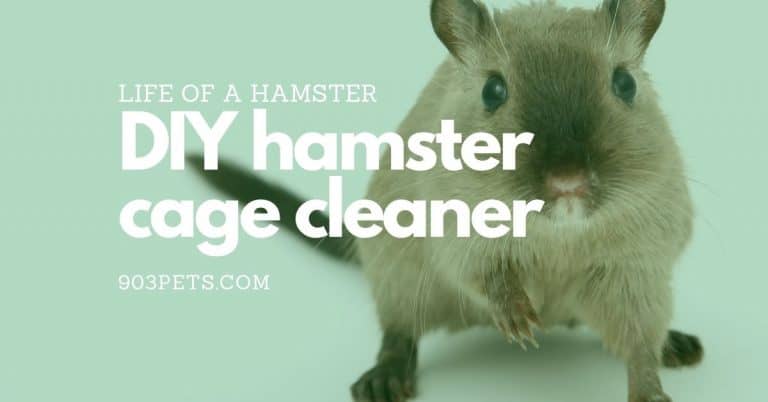How To Clean A Hamster Cage Step-by-Step [Schedule & Tips]
Yay! You have a new pet hamster. But what’s that smell? When was the last time you cleaned your hamster cage?
As a rule, cleaning a hamster cage includes a schedule of daily spot cleaning, weekly bedding change, and monthly full cleaning. A clean hamster cage is important in order to maintain a healthy environment for the hamster. Full cleaning is done by removing the hamster from the cage, removing all bedding and accessories, and washing and soaking the cage. The cage should then be rinsed and dried, and bedding and accessories should be added back in. The hamster can then be put back into the cage.
So, let’s take a few minutes and walk through the ideal hamster cage cleaning process. Don’t miss our tips to help make the process easier on your and your little hammie.
![How To Clean A Hamster Cage Step-by-Step [Schedule & Tips] 1 Cleaning a hamster cage step by step [schedule]](https://cdn-0.903pets.com/ifywhoft/2022/03/Cleaning-a-hamster-cage-step-by-step-schedule.png)
Why Keeping a Clean Hamster Cage is Important
A clean hamster cage is important for several reasons. First, it helps to keep your hamster healthy. A clean cage will reduce the chances of your hamster getting sick from bacteria or other contaminants. This can be in the form of respiratory infections, skin problems, and even diseases.
Our Pick For Best Hamster Bedding
Studies and research suggest that paper bedding is best for our hammies. The Carefresh natural paper bedding for small animals is our top pick to use, today.
What We Like:
- Natural paper bedding
- 99% dust free – Reduced cause of respiratory issues for hamsters and human in some cases.
- Up to 10 Days of ammonia odor control
- Good for tunneling and burrowing
- Reduced chance for cuts from sharp portions
- Good absorbency
![How To Clean A Hamster Cage Step-by-Step [Schedule & Tips] 2](https://cdn-0.903pets.com/ifywhoft/2022/05/Carefresh-Natural-Hamster-Bedding.jpg)
Second, a clean cage will also help to keep your home clean. If your cage is dirty, it can spread dirt and debris to your floors and furniture. This can be a big problem if you have allergies or asthma. A dirty cage can also attract bugs, which can be a nuisance.
Finally, a clean cage will also help to keep your hamster happy. A dirty cage can be stressful for your hamster and may cause them to become anxious or depressed. A hamster that is stressed or unhappy is more likely to bite, which can be dangerous for you and your family.
So, as you can see, there are many good reasons to keep your hamster cage clean. By taking a few minutes each week to clean the cage, you can help to keep your hamster healthy, your home clean, and your hamster happy.
Hamster Cage Cleaning Schedule
Cleaning a hamster is not the same all the time. In fact, we recommend a schedule of cleaning that breaks down daily, weekly and monthly cleanings.
| Cleaning Frequency | Hamster Cage Cleaning Type Description |
|---|---|
| Daily | Spot Clean. Pick up visible messes and uneaten food. Remove soiled bedding areas and replace with fresh bedding. Replace fresh water. |
| Weekly | Bedding Refresh. Remove all bedding and replace with fresh bedding. Clean water bottle and food dishes. |
| Monthly | Full Clean. Remove all bedding and accessories. Clean all surface and accessories. Refresh all consumable goods. |
Below, we’ll describe the monthly full clean process as it is the most complete cleaning effort and may take 45-90 minutes to do fully.
What You’ll Need – Supplies you will need to clean your hamster cage
Cleaning your hamster cage is an important part of hamster ownership. Not only does it keep your hamster healthy and happy, it also helps to keep your home clean. Here is a list of supplies you will need to deep clean your hamster cage:
- Cage cleaner (Commercial or DIY)
- Water
- Paper towel or rag
- Bucket
- Scrub brush
- Vacuum
- Cotton swabs (optional)
- Portable hamster carrier (or alternative)
Small animal cage cleaners can be purchased at most pet stores. Personally, I most recently liked using the Natural Chemistry Healthy Habitat Cleaner and Deodorizer Reptile & Small Pets spray (Amazon link if you want to try it. It’s an affiliate link so it does help support this site.) Now, transparently the trigger pump on the bottle stopped spraying well about halfway through the bottle but I just poured it into a spare spray bottle and kept using it.
Alternatively, you can try a DIY hamster cage cleaner. There’s a recipe for it in our article, here.
For commercial cage cleaner products, you will want to make sure to read the directions on the bottle before using it. Generally, you will want to mix the cleaner with water in a bucket, and then soak the paper towel or rag in the mixture.
Wipe down the entire cage, making sure to get into all the nooks and crannies. You can also use a scrub brush to help loosen any built-up dirt or excrement. If you have any cotton swabs, you can use them to clean the bars of the cage where they meet each other.
Let’s walk through each step so we don’t miss anything important.
![How To Clean A Hamster Cage Step-by-Step [Schedule & Tips] 3](https://cdn-0.903pets.com/ifywhoft/2022/03/Strong-paper-towels-or-scrub-sponge-for-cleaning-hamster-cages-1024x536.png)
Steps to take to clean your hamster cage
1. Remove your hamster from the cage
Before you start cleaning your hamster’s cage, you need to remove your hamster from the cage. This is important for two reasons.
First, you don’t want your hamster to be in the way while you’re cleaning. Second, you don’t want your hamster to inhale or contact any cleaning chemicals.
Lastly, we’ll be using a vacuum and don’t want to accidentally suck up your hamster which could be instant death. Be careful!
When you remove your hamster, place them in a safe place, like a travel carrier, where they can’t escape and will be safe until you’re done cleaning. Be sure they have a water bottle and some food in case they get hungry while they wait. Now that your hamster is out of the way, we can start cleaning their cage.
2. Remove all bedding, toys, and food from the cage
Before you start cleaning your hamster’s cage, you’ll need to remove all bedding, toys, and food. This will help you avoid any potential accidents and make the cleaning process go more smoothly. Plus, in order to fully clean the hamster cage, you need access to every part of it.
Start by removing everything that is not bedding or substrate. Put the toys, exercise wheel, dishes, and anything else in a safe place. Separate all the porous items in one section and anything that is non-porous in another. We’ll be cleaning these items in a step below so keep them close by.
Next, it’s time to deal with the bedding and substrate. The old bedding will need to be disposed of in an environmentally friendly way. Compost old bedding when you can. It’s a great way to help create soil for your raised plant beds.
For other substrates like soil and sand, I like to have a sieve sitting on top of a bucket. Then I can scoop out the substrate, if still viable, dump it in the sieve, and shake. This allows the small substrate to go through the sieve and into the bucket while catching anything larger so it can be tossed out.
This process also aerates the soil and sand allowing them to breathe.
PRO TIP: Keep some of the current bedding from before the cleaning. When you add the new bedding after cleaning, put the reserved old bedding in an area where you hamster typically like to sleep. This will help them feel safe and in a place they know until they get use to all the new bedding and layout of the enclosure.
3. Vacuum out all dust, debris, and remaining bedding
Now it’s times to remove any remaining loose debris. For this, we’ll use a vacuum.
You can use a shop vac if there is any wet debris, but I usually use our regular Dyson pet vacuum with the wand attachment. Obviously, don’t vacuum up liquids with your home vacuum cleaner!
The reason we get all the loose debris up is that is makes our wet cleaning process easier and more effective. Once the wet cleaner is applied, and loose debris would turn to mud and cleaning nasty, filthy mud from the corners of your hamster cage is hard and takes more time.
4. Wash the cage using your cleaner
The next step is to wash the hamster cage. Here’s the process I like to use as it helps maximize the cleaning time.
Depending on the cleaner and cleaning method you chose, wet every surface, cage bar, and door of your hamster cage.
If you chose a spray bottle application, spray all surface and bars down.
If you chose the bucket method, soak the rage in the cleaning solution, wring out most of the liquid, and then liberally wet every surface and bar.
Next, take a toothbrush or other scrub brush and scrub away any stuck on pieces of debris or dried-on messes. Then use the brush to clean all corners and seams of the enclosure.
At this point, I leave the cleaner sitting while I move on to clean the toys, food and water dishes.
NOTE: Be careful if your enclosure is wooden. Do not let your cleaner sit and soak into the wood. Damage may result. Use only the smallest amount of liquid cleaner that is needed. Untreated wood will swell if it is allowed to absorb too much water. I find it best to wet, clean, and then dry sections at a time so that the liquid does not sit on the wood for very long.
![How To Clean A Hamster Cage Step-by-Step [Schedule & Tips] 4](https://cdn-0.903pets.com/ifywhoft/2022/03/DIY-Hamster-cage-cleaner-1024x536.png)
5. Clean toys, dishes, and accessories
Ok, it’s time to clean the accessories. Remember that we separated the porous and non-porous materials? That just means we put all the hard surface items (non-porous) in one pile and anything that could soak up the cleaner (porous) in another pile.
For each of the porous items, like wood hides, wood bridges or walls, we don’t want to spray them with a cleaner as we won’t be able to get it all out and we don’t want to hurt our hammie. So, instead, let simply give them a rub down and knock and nasties off of them. If they are too soiled to be cleaned, it might be time to replace them.
Now, for the non-porous items like water bottles, food dishes and exercise wheels, we’ll use a solution of mild, unscented, liquid hand soap and water. The ratio doesn’t have to be exact but maybe one pump of hand soap to 4-6 cups of warm water.
Use a rag, wet with our soap solution, to clean each of these items. Then thoroughly rinse each item under running water. You want to be sure to get all the soap off the item, especially anything your hamster eats or drinks from.
6. Rinse the cage well and allow it to dry completely
Now that the accessories are clean, turn your attention back to the cage. Give it a final brushing for anything that needed a little extra soak time.
Good, the hard part is done. Take your hamster cage and rinse every inch of it with water to get rid of the cleaner residue.
You can dump your cleaning bucket, rinse it and fill it with clean water. Then with a new rag wipe off the cleaner, rinse and repeat.
Another option with plastic or glass cages is to take it outside and rinse it thoroughly with a hose.
The last part of this step is to allow the cage to thoroughly dry. You don’t want to put fresh bedding in a wet enclosure because it will increase the opportunity for mold and bacteria to grow.
PRO TIP: Take a dry towel and wipe down the cage. Then, place a fan blowing into and through your cage. It will reduce the time it take to dry the cage. Don’t use a hair dryer or heat gun. You could make it too hot for your hamster to be put in for a while or could even cause damage to sealants, glues or plastic parts.
NOTE: Wood cages are different. You probably can’t take it outside and hose it down. That’s why we use a light touch to our cleaning and only use a small animal cleaner that is made specifically to keep our hamsters safe. Then let the cage dry completely. That’s why so many hamster owners like to use aquarium tanks for their enclosures. They are easy to clean.
![How To Clean A Hamster Cage Step-by-Step [Schedule & Tips] 5](https://cdn-0.903pets.com/ifywhoft/2022/03/hamster-cleaning-schedule.png)
7. Add fresh bedding, food, and water to the cage
Woohoo! Now the fun begins again. Why? Because this is a chance to give fresh thinking to how you build your hamsters environment based on what they like best and maybe try one new idea at a time.
First, add your substrate and/or bedding. Don’t forget that you want some areas to be over 10″ deep with bedding to allow ample opportunity for burrowing. Not sure what we’re talking about? Check out our article about bedding depth and hamster happiness. Then pop over to the hamster bedding calculator to get the numbers.
After the bedding and substrate, design the environment with your walls, tunnels, and hides. Think about giving plenty of open space to explore and move around in.
Finally, add back the rest of your accessories.
Don’t forget to refill the water!
8. Put your hamster back in the cage
And the last step is to put your hamster back into it’s enclosure.
No pro tips or extra explanation. Just be gentle and then leave them alone for a day while they get settled into their new environment.
Sometimes a nice treat and a regular meal are helpful.
How often you should be cleaning your hamster cage
It is generally recommended that you clean your hamster cage once a week. However, if you notice that the cage is particularly dirty, you may need to clean it more often. Alternatively, you may find that quickly removing any particular messes and unused food daily can extend the time between deep cleanings.
Keep in mind that some hamsters are messier than others. If you have a Syrian hamster, you may find that you need to clean the cage more often than if you had a dwarf hamster simply because of the difference in size. Bigger hamsters can leave behind bigger messes.
![How To Clean A Hamster Cage Step-by-Step [Schedule & Tips] 6](https://cdn-0.903pets.com/ifywhoft/2022/03/Avoid-using-harsh-cleaning-products-when-cleaning-hamster-cages-1024x536.png)
5 Ways to Make Cleaning Your Hamster Cage Easier
Cleaning your hamster cage doesn’t have to be a difficult task. In fact, there are a few things you can do to make the process easier. Here are five ways to make cleaning your hamster cage easier:
- Use the proper supplies – Having the right supplies on hand will make cleaning your hamster cage much easier. Be sure to have a good cage cleaner, a microfiber towel, a good quality brush, and a vacuum.
- Clean on a regular basis – Trying to clean a cage that hasn’t been cleaned in a while can be quite difficult. It’s much easier to clean a cage that is cleaned on a regular basis.
- Use a dustpan to scoop out the bedding or substrate – Using a dustpan to scoop out the bedding is the easiest way to clean a hamster cage. You can find a dustpan at any hardware store.
- Have a plan – Having a plan of attack before you start cleaning will make the process much easier. Decide what order you are going to clean things in and stick to it.
- Shop-Vac to the rescue – You can skip the dustpan, remove loose debris and even reduce the drying time after rinsing by using a Shop-Vac. I picked up the Stanley Wet/Dry Vacuum, 4 Gallon, 4 Horsepower, Stainless Steel Tank (Amazon link) on sale locally a while back and it works great for this and regular bedding with its 1.25″ hose diameter. If you use really big bedding, you might need a model with a wider hose size.
Following these tips will help you make cleaning your hamster cage an easier task.
What to do if your hamster cage smells bad
If your hamster cage smells bad, there are a few things you can do to clean it up.
First, identify the source of the smell.
If it is coming from the bedding, you will need to replace it. If the smell is coming from the food or water, you will need to clean those items. If the smell is coming from the hamster itself, you will need to give it a bath.
Signs that your hamster cage is too dirty
A dirty cage can lead to a number of health problems for your hamster, so it’s important to be aware of the signs that their cage needs to be cleaned.
One of the most obvious signs that your hamster cage is too dirty is the smell. If the cage smells bad, it’s probably time for a cleaning.
Another sign is if you see any mold or mildew growing in the cage. This can be harmful to your hamster, so it’s important to clean it as soon as you see it.
Another sign that your hamster cage is too dirty is if your hamster is starting to show signs of illness. If they’re not acting like their usual selves, or if they’re losing weight, it could be because their cage is dirty and they’re not getting the proper care they need. If you see any of these signs, it’s important to clean your hamster cage as soon as possible and have them seen by a vet.
A dirty cage is not only dangerous for your hamster, but it can also be very unpleasant for you as well.
Wrap Up
Keeping a hamster cage clean is important for their health and safety. But it is also helpful to the those in your home.
A clean cage will reduce the chances of your hamster getting sick and helps to keep your home clean. A dirty cage can also attract bugs, which can be a nuisance. Keeping a hamster cage clean also reduces stress for your hamster, keeping them happier and healthier.
By taking a few minutes each week to clean the cage, you can help to keep your hamster healthy, your home clean, and your hamster happy.
If you think your pet is ill, call a vet immediately. All health-related questions should be referred to your veterinarian. They can examine your pet, understand its health history, and make well informed recommendations for your pet.
903pets.com Staff


![How to Pet a Hamster: 9 Happy vs. Unhappy Signs 7 Do hamsters like to be petted and held? [Answers]](https://cdn-0.903pets.com/ifywhoft/2021/05/How-to-Pet-a-Hamster-Happy-vs.-Unhappy-Signs-768x402.jpg)
![What Do Hamsters Eat [Do's and Don'ts] 9 What Can Hamster Eat Dos and Donts](https://cdn-0.903pets.com/ifywhoft/2022/01/What-Can-Hamster-Eat-Dos-and-Donts-768x402.jpg)



